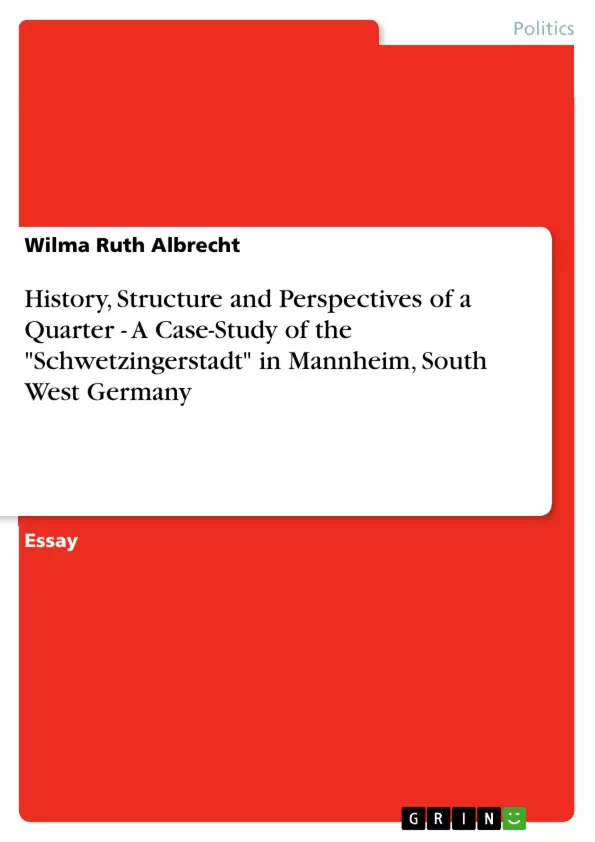According to the specific aspects and forms of the historical formation and development of the quarter Schwetzingerstadt itself a detailed overview(13) demonstrates not only the different forms of settlement at the territory of the today Schwetzingerstadt including the specific variations and change of the quarter's character since the rniddle ages but illustrates and underlines my basic theses - that it is the social mode of production itself which dominates (however mediated, but, as Frederick Engels has pointed out, 'in the last instance) the way of settlement of groups and individuals even at the level of the microstructure of a quarter.
Table of Contents
- Introduction
- Levels of Regional Analysis
- Relevant Literature
- Historical Development
- Empirical Analysis and Social Indicators
- Concepts of Human Settlement
- Socio-Cultural Approach
- Socio-Ecological Approach
- Historical Materialist Approach
- Historical Formation and Development of Schwetzingerstadt
- Schwetzingerstadt in the Middle Ages
- Post-Medieval Development and Industrialization
- Micro-Spatial Structure and Settlement Patterns
- Social Change and Segregation Processes
Objectives and Key Themes
This case study analyzes the historical development, spatial structure, and future prospects of the Schwetzingerstadt quarter in Mannheim, Germany. It examines the interplay between social, economic, and spatial factors in shaping the quarter's evolution.
- The historical development of Schwetzingerstadt from the Middle Ages to the present.
- The influence of different modes of production on settlement patterns.
- Analysis of the socio-cultural, socio-ecological, and historical materialist approaches to urban planning.
- Empirical analysis of the current social and spatial structure of Schwetzingerstadt.
- The potential for social segregation and change within the quarter.
Chapter Summaries
The introduction outlines the author's previous work on regional development and introduces the focus on the Schwetzingerstadt. The subsequent sections delve into various levels of analyzing the quarter, starting with a review of relevant literature on settlement and town planning. A historical approach traces the specific development of Schwetzingerstadt, highlighting its evolution from feudal times onwards. An empirical analysis of the quarter's structure is undertaken, considering various theoretical viewpoints on urban planning including socio-cultural, socio-ecological, and historical materialist perspectives. The study further examines the interplay between the modes of production and the settlement patterns within Schwetzingerstadt throughout its history, analyzing how various factors influenced its spatial and social structure. A detailed overview of the historical formation and development of the quarter demonstrates the social mode of production's influence on settlement patterns even at the micro-structural level. The analysis will also examine the current socio-economic trends within Schwetzingerstadt and explore the potential for future social and spatial change.
Keywords
Regional development, urban planning, historical materialism, socio-cultural approach, socio-ecological approach, Schwetzingerstadt, Mannheim, Germany, spatial structure, social change, settlement patterns, modes of production, micro-spatial analysis, social segregation.
- Quote paper
- Dr. Wilma Ruth Albrecht (Author), 1989, History, Structure and Perspectives of a Quarter - A Case-Study of the "Schwetzingerstadt" in Mannheim, South West Germany, Munich, GRIN Verlag, https://www.grin.com/document/109187



